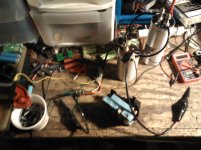I got mine to work, following these plans: http://ledhacks.com/power/battery_tab_welder.htm
The problem is, the welds are tiny and pull off way too easily. Could it be that my capacitor is not enough (real) farads? Maybe my power supply needs to be more like 15v instead of 12.36v?
Or perhaps my thyristor needs a bit more voltage to open the gate properly? I was using a tiny AAA battery, which had voltage dropped to .88v by the time it gets to the thyristor. I broke my first thyristor with too much voltage on the gate, so I'm trying to be careful with this one. This one is 70amps and a lot bigger (physically) than my first one which was listed as 100amps.
I'm using 8g wire for the probe leads, that shouldn't be an issue. I do see the voltage on the capacitor drop to 1v immediate upon activation.
The problem is, the welds are tiny and pull off way too easily. Could it be that my capacitor is not enough (real) farads? Maybe my power supply needs to be more like 15v instead of 12.36v?
Or perhaps my thyristor needs a bit more voltage to open the gate properly? I was using a tiny AAA battery, which had voltage dropped to .88v by the time it gets to the thyristor. I broke my first thyristor with too much voltage on the gate, so I'm trying to be careful with this one. This one is 70amps and a lot bigger (physically) than my first one which was listed as 100amps.
I'm using 8g wire for the probe leads, that shouldn't be an issue. I do see the voltage on the capacitor drop to 1v immediate upon activation.



